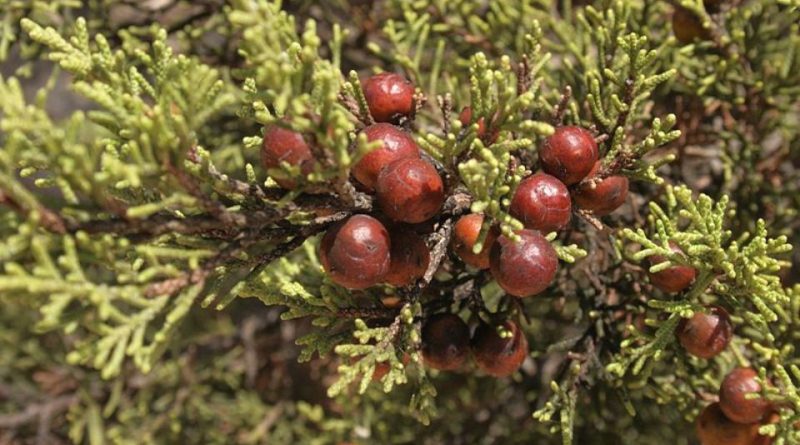Juniperus phoenicea
Juniperus phoenicea
The Phoenician juniper or Cedar Lycio (Juniperus phoenicea L., 1753) is a shrub species belonging to the Cupressaceae family.
Systematics –
From the systematic point of view it belongs to the Domain Eukaryota, Kingdom Plantae, Subarign Tracheobionta, Superdivisione Spermatophyta, Division Pinophyta, Classe Pinopsida, Order Pinales, Family Cupressaceae and then to the Genus Juniperus and to the Species J. Phoenicea.
Etymology –
The term Juniperus comes from iúnix, heifer and from pário, giving birth, giving birth: for presumed properties favoring childbirth. The specific phoenicean epithet could derive from the Greek φοινίκιος foinícios which is synonymous with the Punic color (Phoenician, from the Phoenices, population that traded the purple) or from φοινος reddening phoinos: purple-red or Fenicia, today the Syro-Palestinian coastal strip.
Geographic Distribution and Habitat –
Juniperus phoenicea is a plant of Mediterranean origins, where it grows on coastal areas, rocky or sandy, especially on calcareous substrates, forming rarely pure formations up to 1300 m. this species is widespread in eastern Spain, including Andorra, in southern France and in a small part of north-west Italy and with extensions to the north and east: from Macaronesia (Cape Verde, Azores, Canary Islands, Madeira) to Palestine and from North Africa to the Pyrenees and the Gulf of Trieste.
Description –
The Phoenician juniper is a shrubby and bushy species that can reach 8 meters, with dark green foliage. It has a straight trunk that becomes twisted near the sea, with smooth, brownish and slightly longitudinally rind. The leaves are persistent, squamiform and opposite, with oval or rhomboidal shape, strictly appressed, 1 mm long; while the leaves of the seedlings are needle-like and pungent. It is a dioecious species with male and female unisexual flowers consisting of small pendulous spikes; these are brought into catkins on the young lateral and terminal branches. The fruits are red-brown, globular and pendulous galbuli, 0.8-1.2 cm in diameter, brought to the tip of the twigs that ripen in autumn and persist for a long time on the plant. It has a very robust root system and is suitable to penetrate even inside the rocks.
Cultivation –
Juniperus phoenicea is a very long-lived but slow-growing tree or shrub that prefers calcareous soils, not necessary deep, as the plant, with its robust root system can penetrate even more brittle rocks. For its cultivation it does not need a lot of water and it is resistant to high temperatures. Multiplication can occur by seed or by cuttings. In the first case, the germination will be more difficult and slow (the seed must be planted in the spring) while with the reproduction by cuttings will shorten the growth times. The cutting must be taken in spring, preferring young branches that have recently developed.
Uses and Traditions –
The Juniperus phoenicea which is also known by the common names of Phoenician juniper, Ginepro licio, Cedro liscio, Sabina marittima and Falsa sabina is a constitutive element of the Mediterranean scrub.
It is a plant with a hard wood, pinkish, compact, differentiated, fine-grained, resinous; it is appreciated in cabinet making and has been used for the manufacture of pencils.
In Libya the young branches of Juniperus phoenicea (containing 2-3% of a very toxic essential oil containing pinene, sabinene, sabinol, geraniol, tannins, etc.), as well as the twigs of Juniper sabina (Juniperus sabina) equipped with strong action emmenagoga and stimulating uterine contractions, are used by local populations to procure abortion with very serious health risk, since they cause burning and irritation of the oro-pharyngeal mucous membranes and stomach with nausea, vomiting violent abdominal pain, headache, hemorrhagic nephritis and muscle cramps.
Its berries, or cuddles are very popular for the extraction of an essential oil called juniper essence that is used in the production of liqueurs such as gin and in medicine and veterinary as a phytotherapeutic.
Preparation Mode –
Juniperus phoenicea in addition to the extraction of essential oils and the use of its wood has no particular food uses.
Guido Bissanti
Sources
– Acta Plantarum – Flora of the Italian Regions.
– Wikipedia, the free encyclopedia.
– Treben M., 2000. Health from the Pharmacy of the Lord, Advice and experience with medicinal herbs, Ennsthaler Publisher
– Pignatti S., 1982. Flora of Italy, Edagricole, Bologna.
– Conti F., Abbate G., Alessandrini A., Blasi C. (edited by), 2005. An annotated checklist of the Italian vascular flora, Palombi Editore.
Warning: Pharmaceutical applications and alimurgical uses are indicated for informational purposes only and do not in any way represent a medical prescription; there is therefore no liability for their use for curative, aesthetic or food purposes.


